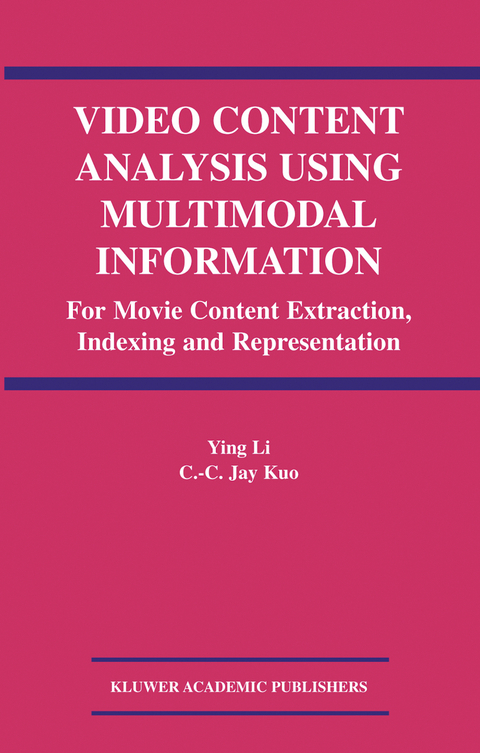
Video Content Analysis Using Multimodal Information
For Movie Content Extraction, Indexing and Representation
Seiten
2003
Springer-Verlag New York Inc.
978-1-4020-7490-5 (ISBN)
Springer-Verlag New York Inc.
978-1-4020-7490-5 (ISBN)
Covers content-based multimedia analysis, indexing, representation and applications with a focus on feature films. This work presents advanced techniques in video content analysis domain, as well as many novel ideas and algorithms for movie content analysis based on the use of multimodal information.
With the fast growth ofmultimedia information, content-based video anal- ysis, indexing and representation have attracted increasing attention in re- cent years. Many applications have emerged in these areas such as video- on-demand, distributed multimedia systems, digital video libraries, distance learning/education, entertainment, surveillance and geographical information systems. The need for content-based video indexing and retrieval was also rec- ognized by ISOIMPEG, and a new international standard called "Multimedia Content Description Interface" (or in short, MPEG-7)was initialized in 1998 and finalized in September 2001. In this context, a systematic and thorough review ofexisting approaches as well as the state-of-the-art techniques in video content analysis, indexing and representation areas are investigated and studied in this book. In addition, we will specifically elaborate on a system which analyzes, indexes and abstracts movie contents based on the integration ofmultiple media modalities. Content ofeach part ofthis book is briefly previewed below.
In the first part, we segment a video sequence into a set ofcascaded shots, where a shot consistsofone or more continuouslyrecorded image frames. Both raw and compressedvideo data will beinvestigated. Moreover, consideringthat there are always non-story units in real TV programs such as commercials, a novel commercial break detection/extraction scheme is developed which ex- ploits both audio and visual cues to achieve robust results. Specifically, we first employ visual cues such as the video data statistics, the camera cut fre- quency, and the existenceofdelimiting black frames between commercials and programs, to obtain coarse-level detection results.
With the fast growth ofmultimedia information, content-based video anal- ysis, indexing and representation have attracted increasing attention in re- cent years. Many applications have emerged in these areas such as video- on-demand, distributed multimedia systems, digital video libraries, distance learning/education, entertainment, surveillance and geographical information systems. The need for content-based video indexing and retrieval was also rec- ognized by ISOIMPEG, and a new international standard called "Multimedia Content Description Interface" (or in short, MPEG-7)was initialized in 1998 and finalized in September 2001. In this context, a systematic and thorough review ofexisting approaches as well as the state-of-the-art techniques in video content analysis, indexing and representation areas are investigated and studied in this book. In addition, we will specifically elaborate on a system which analyzes, indexes and abstracts movie contents based on the integration ofmultiple media modalities. Content ofeach part ofthis book is briefly previewed below.
In the first part, we segment a video sequence into a set ofcascaded shots, where a shot consistsofone or more continuouslyrecorded image frames. Both raw and compressedvideo data will beinvestigated. Moreover, consideringthat there are always non-story units in real TV programs such as commercials, a novel commercial break detection/extraction scheme is developed which ex- ploits both audio and visual cues to achieve robust results. Specifically, we first employ visual cues such as the video data statistics, the camera cut fre- quency, and the existenceofdelimiting black frames between commercials and programs, to obtain coarse-level detection results.
1. Introduction.- 2. Background and Previous Work.- 3. Video Content Pre-Processing.- 4. Content-Based Movie Scene and Event Extraction.- 5. Speaker Identification for Movies.- 6. Scene-Based Movie Summarization.- 7. Event-Based Movie Skimming.- 8. Conclusion and Future Work.- References.
| Erscheint lt. Verlag | 30.6.2003 |
|---|---|
| Zusatzinfo | XXIII, 194 p. |
| Verlagsort | New York, NY |
| Sprache | englisch |
| Maße | 155 x 235 mm |
| Themenwelt | Mathematik / Informatik ► Informatik ► Grafik / Design |
| ISBN-10 | 1-4020-7490-5 / 1402074905 |
| ISBN-13 | 978-1-4020-7490-5 / 9781402074905 |
| Zustand | Neuware |
| Haben Sie eine Frage zum Produkt? |
Mehr entdecken
aus dem Bereich
aus dem Bereich
Schritt für Schritt zu Vektorkunst, Illustration und Screendesign
Buch | Hardcover (2023)
Rheinwerk (Verlag)
CHF 55,85
Fit für Studium und Ausbildung
Buch | Softcover (2022)
Rheinwerk (Verlag)
CHF 34,85


